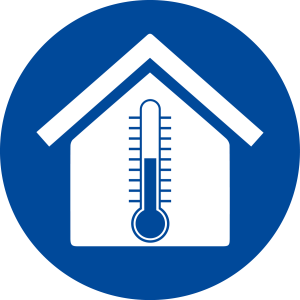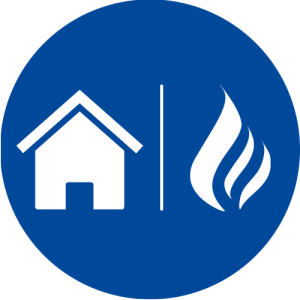AAC's Advantages
Building material AAC
AAC is a very strong but lightweight and easy-to-use construction material. It can be used for all applications including walls, roofs, floors and balconies, in both load-bearing and non-load bearing applications. Produced for more than 80 years, AAC offers considerable advantages over other construction materials:
High thermal insulation
 High energy efficiency is one of the determining characteristics of autoclaved aerated concrete. AAC’s cellular structure gives it a thermal efficiency 10 times higher than that of aggregate concrete and two to three times better than clay brick. Consequently, buildings made of AAC are warm in winter and cool in summer. The air bubbles trapped in AAC provide thermal insulation much greater than conventional concrete and clay bricks.
High energy efficiency is one of the determining characteristics of autoclaved aerated concrete. AAC’s cellular structure gives it a thermal efficiency 10 times higher than that of aggregate concrete and two to three times better than clay brick. Consequently, buildings made of AAC are warm in winter and cool in summer. The air bubbles trapped in AAC provide thermal insulation much greater than conventional concrete and clay bricks.
Excellent fire and heat resistance
 AAC provides the ultimate security against fire, resisting even intense heat and easily fulfilling all fire safety standards. The building material meets the most stringent fire safety requirements. Due to its purely mineral composition, AAC is classified as a non-combustible building material. It is both resistant to fire up to 1200°C and, unlike other construction materials, heat-resistant. Besides being fire- and heat-resistant, AAC does not give off any smoke or toxic gases.
AAC provides the ultimate security against fire, resisting even intense heat and easily fulfilling all fire safety standards. The building material meets the most stringent fire safety requirements. Due to its purely mineral composition, AAC is classified as a non-combustible building material. It is both resistant to fire up to 1200°C and, unlike other construction materials, heat-resistant. Besides being fire- and heat-resistant, AAC does not give off any smoke or toxic gases.
Good workability
 Its light weight/cellular properties make it easy to cut, shave, and shape, accept nails and screws readily, and allow it to be routed to create chases for electrical conduits and smaller-diameter plumbing runs. This gives it design and construction flexibility, and the ability to make easy adjustments in the field. Thus, the construction time is substantially reduced when AAC blocks are used. This is due to the fact that these blocks are larger and lighter than conventional blocks and hence can be installed at a quicker rate. Blocks are laid flush utilising thin joint mortar thus reducing mortar and plastering cost and eliminating thermal bridging. Workability allows accurate cutting, which minimizes the generation of solid waste during use.
Its light weight/cellular properties make it easy to cut, shave, and shape, accept nails and screws readily, and allow it to be routed to create chases for electrical conduits and smaller-diameter plumbing runs. This gives it design and construction flexibility, and the ability to make easy adjustments in the field. Thus, the construction time is substantially reduced when AAC blocks are used. This is due to the fact that these blocks are larger and lighter than conventional blocks and hence can be installed at a quicker rate. Blocks are laid flush utilising thin joint mortar thus reducing mortar and plastering cost and eliminating thermal bridging. Workability allows accurate cutting, which minimizes the generation of solid waste during use.
Breathability
 The superior thermal insulation of AAC results in a comfortable and constant indoor environment. AAC is breathable and therefore allows the diffusion of moisture vapour, helping to moderate moisture levels within a building. AAC walls self-regulate indoor humidity levels by automatically absorbing and releasing moisture. This is vital for maintaining correct relative humidity, preventing condensation and associated problems with fungal moulds. Breathable acrylic exterior coatings provide a water resistant barrier while still allowing moisture vapour transfer.
The superior thermal insulation of AAC results in a comfortable and constant indoor environment. AAC is breathable and therefore allows the diffusion of moisture vapour, helping to moderate moisture levels within a building. AAC walls self-regulate indoor humidity levels by automatically absorbing and releasing moisture. This is vital for maintaining correct relative humidity, preventing condensation and associated problems with fungal moulds. Breathable acrylic exterior coatings provide a water resistant barrier while still allowing moisture vapour transfer.
Great energy efficiency and cost-effectiveness
 AAC has excellent thermal insulation properties, reducing the need for space heating or air conditioning. This results in considerable savings in relation to necessary air conditioning and cooling and accordingly also in electricity consumption. This reduction can be between 50 and 70%. AAC blocks are approximately one-fifth the weight of normal concrete. Total construction cost saving can be achieved through reduction in working load of foundation and steel bar. In addition, reductions in maintenance, energy bills and insurance are realized thereafter.
AAC has excellent thermal insulation properties, reducing the need for space heating or air conditioning. This results in considerable savings in relation to necessary air conditioning and cooling and accordingly also in electricity consumption. This reduction can be between 50 and 70%. AAC blocks are approximately one-fifth the weight of normal concrete. Total construction cost saving can be achieved through reduction in working load of foundation and steel bar. In addition, reductions in maintenance, energy bills and insurance are realized thereafter.
Lightweight
 AAC is lightweight, about a fifth the weight of concrete. AAC is much lighter than brick or concrete and does not usually need to be combined with insulation materials, so it is extremely cost-effective. With an approximate density of (450-550)Kg/m3, AAC blocks are only approximately one third of the weight of equivalent hollow concrete blocks and half of the weight of light weight aggregate block. The result is that it reduces the load on concrete structures and foundations of a building substantially. This saves considerable construction time as well as the total materials required for the construction of an entire building.
AAC is lightweight, about a fifth the weight of concrete. AAC is much lighter than brick or concrete and does not usually need to be combined with insulation materials, so it is extremely cost-effective. With an approximate density of (450-550)Kg/m3, AAC blocks are only approximately one third of the weight of equivalent hollow concrete blocks and half of the weight of light weight aggregate block. The result is that it reduces the load on concrete structures and foundations of a building substantially. This saves considerable construction time as well as the total materials required for the construction of an entire building.
Moreover, AAC is known for its durability and dimensional stability. It resists water, rot, mold, mildew, and insects. Units are precisely shaped and conform to tight tolerances. Even its environmental performance is exemplary: All solid materials such as silica sand, quicklime and/or cement as a binding element, water and aluminum as a propellant have a natural origin and an almost worldwide occurrence. AAC can be completely recycled during production. It is nonhazardous in further processing.